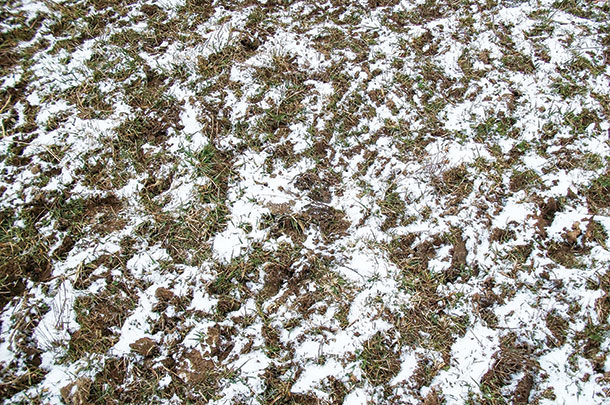Some are happy with their results and some are not so happy. I believe there are several reasons failures occur, but there are also things we can do to increase the success rate when using this method. We’ll discuss some of them here.
Let’s look at some reasons why one might want to use frost seeding when trying to establish new forage plants:
1 There is not a lot of expensive or special equipment needed for the task. Using a broadcast seeder on the back of a tractor or an ATV, which most farmers already have, does not cost much and a lot of ground can be covered with a little effort. Even using a hand broadcast seeder a producer can cover several acres easily.
2 Frost seeding does not require the sod to be disturbed or the area taken out of production until the new plants are well established, like a conventional seeding. The existing forage may still be used as the new plants develop and mature.
3 Labor and energy costs to accomplish this type of seeding are minimal.
Why is the problem occurring?
If the area you intend to frost seed currently has poor growth, the first thing you need to determine is, “Why is the problem occurring?” By adding more seed to soil that lacks proper nutrient levels, has a pH that is too low or high for the intended crop or if the pasture is not being managed properly (for example, repeated close grazings), the soil is not going to grow more of the desired forage if you just broadcast more seed.
Is overgrazing the problem? When plants are severely overgrazed and regrazed before a sufficient rest period has elapsed, the plant takes energy that has been stored in the roots as carbohydrates to support new leaf growth. As carbohydrates are removed from the roots, the root dies, separates from the plant and eventually decomposes.
This process continues until enough new leaf surface grows to catch sufficient amounts of solar energy and re-establish lost roots. Depending on the severity of root loss, forage regrowth may be very slow to accumulate.
A soil test should be done if the level of nutrients in the soil is not known. Forage plants require adequate nutrients to grow and maximize production. Phosphorus (P) is necessary to establish new seedlings and is particularly important for encouraging root growth.
Sufficient potassium (K) is also needed by grasses and especially legumes if you want high-yielding pastures. Soil test minimum nutrient levels should be 40 to 50 ppm P (80 to 100 pounds per acre) and 150 to 200 ppm K or (300 to 400 pounds per acre).
Weeds and residual forage control
Producers should control problem weeds before frost seeding. Once legume plants start to grow, any herbicide application to kill broadleaf weeds will also kill the frost-seeded legumes. Weeds are nitrogen scavengers and not only reduce grass growth around them, but can decrease the quality of forage in a pasture. This is especially true if stockpiling forage is one of your goals.
Weeds growing in stockpiled forage often die with the first frost and lose quality rapidly, leaving the overall forage quality reduced.
Producers should remove excess growth before frost seeding. One can use livestock or a brush hog to do this. Removing or cutting this plant material will provide needed openings above the soil to allow seeds to fall to the ground.
Grass seed or legumes can be used, but frost seeding works best with legume seeds because it is easier for smaller seeds to drop to the soil surface than it is for the larger (but lighter) grass seeds.
Encouraging legume plants in forage growth can lower production costs. Stands that contain approximately 30 to 35 percent legumes generally need no additional nitrogen to obtain good growth. Legumes also improve the quality characteristics of a grass stand.
Several research studies have shown that having legumes like red clover mixed within a pasture sward that has a lot of fescue in it, not only increases forage production, but also benefits livestock production factors like improved weight gain and increased conception rates.
Some key points
Legumes should be inoculated before seeding. Some companies apply an inoculant coating on their legume seed and some do not. Therefore, producers need to check when purchasing seed to be sure what they are getting and if they need to apply the inoculant before seeding.
Late winter, February or early March is a good time to frost seed pastures in Ohio. Broadcast your selected seed while the ground is frozen. The freezing action makes the soil surface like a honeycomb, providing small pockets for seed to make good soil contact. This is necessary if seeds are to grow and compete with established plants.
Finally, as growth begins in the spring, new legume seedlings will have a better chance to start if they have help competing against established plants. Frost-seeded pastures should be grazed lightly or clipped in the spring at regular intervals when grass plants are approximately 8 inches in height.
This will allow sunlight to enter the canopy so new legume seedlings are not shaded out. However, do not allow animals to graze seeded areas so heavily (to heights less than 3 to 4 inches) that they ruin the new seeding before adequate roots are developed.
A temporary electric fence may be needed to control livestock and prevent overgrazing. Strict grazing management to allow plants an adequate rest period after each grazing pass must be implemented to produce strong root systems and maintain healthy plant growth. If continuous unmanaged grazing is allowed to occur, your frost seeding efforts will be pointless.
If a frost seeding was made in a hay field, do not apply high rates of nitrogen fertilizer to first-cutting hay. Established grass plants in mixed grass/legume stands will out-compete the newly seeded legume plants and shade them out.
Plan to make first-cutting hay on any frost-seeded fields early in the season (mid-May) if weather and field conditions permit. Grass height in second-cutting hay will not be as much of a problem, and new legume plants will be further developed to compete better with the grasses.
Summary
Frost seeding will not increase the productivity or quality of forages if soil nutrients and pH are not in acceptable ranges for the species you are trying to grow. Most often, pastures are a product of management practices. Many times a change in grazing practices (allowing rest periods) or addition of soil nutrients will correct declining pasture production.
If you are thinking of frost seeding and do not know what your nutrient levels are, a soil test can be a valuable tool. It can tell you if your pastures need more seed or just more “feed.” ![]()
PHOTO: Late winter, February or early March is a good time to frost seed pastures in Ohio. Broadcast your selected seed while the ground is frozen. Photo provided by Mark Landefeld.

-
Mark Landefeld
- Extension Educator
- Ohio State University
- Email Mark Landefeld












